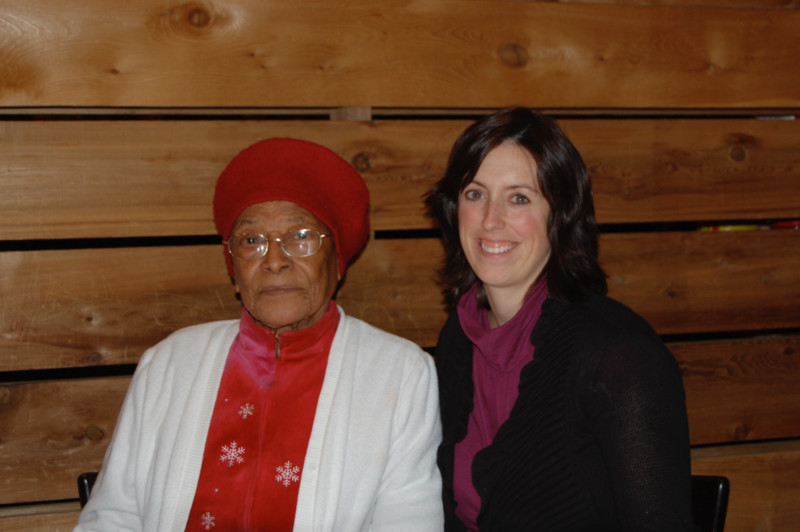Sign up for the daily CJR newsletter.
I almost fell out of my chair when Oprah Winfrey told the nearly 20 million people watching the 2018 Golden Globes in January about a woman whose bold testimony sparked a nationwide anti-rape campaign decades before the #MeToo movement. “Recy Taylor,” Winfrey said, is “a name I know and I think you should know, too.” Then she told a story with which I was intimately familiar.
Recy Taylor was a young African-American mother and wife in Abbeville, Alabama, who in 1944 was kidnapped and raped at gunpoint by seven white men. They threatened to kill her if she talked, but as soon as she was in the safe embrace of her father, husband, and local sheriff, she detailed the brutal assault. A few days later, a representative from the Montgomery NAACP called to say he would send his best detective. Her name was Rosa Parks.
ICYMI: Meet the journalism student who found out she won a Pulitzer in class
Parks arrived on Taylor’s front porch with a notebook and a pen, carefully documenting Taylor’s assault, then spirited that testimony back to Montgomery, where she and the city’s most militant Black activists launched the “Committee for Equal Justice for Mrs. Recy Taylor.” Within a few months, chapters sprouted up across the nation, prompting the Chicago Defender to call it the “strongest campaign for equal justice to be seen in a decade.”
It was “somewhere in Rosa Parks’s heart almost 11 years later,” Winfrey said in closing, “when she made the decision to stay seated on that bus in Montgomery, and it’s here with every woman who chooses to say, ‘me, too.’” It was an incredible eulogy for Taylor, who passed away on December 28, and an enduring testament to her courageous stand decades before anyone said #MeToo.
Historians are detectives and storytellers. No story ever comes in whole cloth.
I knew exactly who Recy Taylor was—not least because I had just returned from her funeral—but because it took me nearly two decades of research in archives from Alabama to North Carolina to New York to Wisconsin to stitch together the story Oprah told in two minutes.
I was thrilled to hear Winfrey give Taylor’s story such an enormous platform—one that even the best historians and storytellers will likely never have. In the days that followed, hundreds of journalists, writers, and bloggers rushed to flesh out the “untold” story of Recy Taylor. In most essays, there was no mention of how her story was recovered or how the connection between Parks, Taylor, and the Montgomery bus boycott was established, much less who recovered it. Once a story circulates widely in the public sphere, like Taylor’s obituary in The New York Times (which I assisted with), it is often considered “true” and in the public domain, and attribution thereafter is forgotten. Plus, few people know how historical narratives are written.
Historians are detectives and storytellers. No story ever comes in whole cloth. We find threads all over the place—one in an archive here; another in an old court transcript there; yet another in a microfilmed newspaper—and pull them to see where they lead. We spend an enormous amount of time and money (often our own) crisscrossing the country and the world chasing these stray threads, hoping they will tell us something new and important about who we are.
Individually, the threads reveal little. But when woven together over years of research, they expose patterns, textures, and details that may have not been otherwise visible. Those patterns and details may look different depending upon how the weaver positions the threads—whether Sally Hemings and her family is a dominant theme in a history of Thomas Jefferson and Monticello, for example, or barely visible. Many of us work with the same “facts,” but how we read, interpret, analyze, and stitch them together is the art of historical writing and storytelling. There are, after all, more than 15,000 books about Abraham Lincoln.
When done well, “history” and its meaning appears as if it were there all along; historians’ best work can find the lost, make visible the disappeared, and resurrect the dead.
When done well, “history” and its meaning appears as if it were there all along; historians’ best work can find the lost, make visible the disappeared, and resurrect the dead. Journalists who consult history for reporting are most likely to find historians with a public presence and whose books are published for popular audiences. But the relationship between historians and journalists can be beautifully symbiotic, providing a larger platform for historians’ work and a grounding for journalists’ own reporting. Ta-Nehisi Coates’s essays for The Atlantic on the Civil War and reparations; Brent Staples’s short “editorial observations” in The New York Times on the history of interracial marriage and slavery; Jamelle Bouie’s article on the legacy of nativism in the United States; and Atlanta Journal Constitution writer Rosalind Bentley’s meditations on Florida’s Underground Railroad and a landmark 1959 sexual violence case come to mind as examples of this collaboration.
So when other writers, bloggers, and public figures take historians’ work, including our analysis, framing, and argument—our intellectual property—and present it as an “untold” story or readymade fact, we feel that without reference or attribution it is not translation. It is presenting our work as their own. Surely this is not their intent.
Now that almost all media is online, it is fairly simple to offer attribution. A hyperlink to historians’ books or essays is one way to acknowledge our work. In print articles, writers could ask us for a quote or identify us as a reliable source. If we spend an hour on the phone directing you to resources, explaining our research, or contextualizing an issue in the news, give credit where it is due. If this is unworkable in the piece, use social media to acknowledge us instead.
In the long term, lack of attribution makes historical research and scholarship invisible—a disservice to readers who hunger for trustworthy stories that make sense of our past and present amid all the bloviation and clickbait. Attribution lends credibility to journalists’ reporting, points readers toward reliable content, and helps draw clear lines between fact and opinion. It also makes the production of knowledge in the arts and humanities visible at a time when its value is questioned throughout the country. Journalists and historians can be allies in these pursuits.
Has America ever needed a media defender more than now? Help us by joining CJR today.








